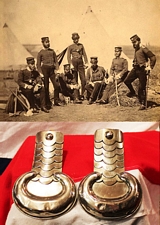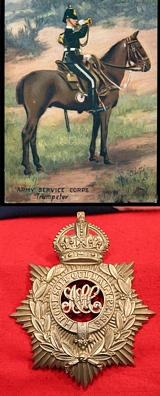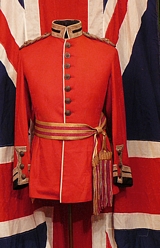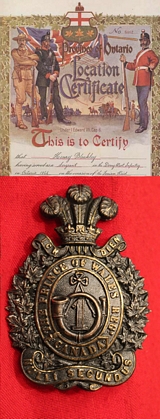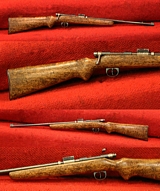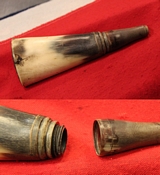Antique Arms & Militaria
A Wonderful Georgian ‘Grand Tour’ or Campaign Travelling Miniature Foldaway Corkscrew and Hook
In delightfully blued steel and only 3.25cm long when folded. Made to be used with very small, corked, glass bottles containing everything from gun oil, for gun cases, to writing ink, poisons or colognes. And as a button hook for shoes, riding boots or gaiters. It could be contained in a travelling officer and gentleman’s gun case, campaign toilette case, sabretache or even waistcoat pocket. It would make a delightful additional accessory for a cased set of duellers, a single pistol or hunting guns. Circa early 1800’s read more
125.00 GBP
A Very Good Pair of Early Victorian Crimean War, British Dragoon Tunic Shoulder Scales
Epaulette is a type of ornamental shoulder piece or decoration used as insignia of rank by armed forces and other organizations. Epaulettes bear some resemblance to the shoulder pteruges of ancient Roman military costumes. However their direct origin lies in the bunches of ribbons worn on the shoulders of military coats at the end of the 17th century, which were partially decorative and partially intended to prevent shoulder belts from slipping. These ribbons were tied into a knot which left the fringed end free. This established the basic design of the epaulette as it evolved through the 18th and 19th centuries.
From the 18th century on, epaulettes were used in the French, British and other armies to indicate rank. The rank of an officer could be determined by whether an epaulette was worn on the left shoulder, the right shoulder or on both. Later a "counter-epaulette" (with no fringe) was worn on the opposite shoulder of those who wore only a single epaulette. Epaulettes were made in silver or gold for officers, and in cloth of various colours for the enlisted men of various arms. By the early eighteenth century, epaulettes became the distinguishing feature of an officer, leading to officers of military units without epaulettes to petition their government for the right to wear epaulettes, to ensure that they would be recognized as officers. Certain cavalry specialties wore flexible metal epaulettes referred to as shoulder scales such as these. During the Napoleonic Wars and subsequently through the 19th century, grenadiers, light infantry, voltigeurs and other specialist categories of infantry in many European armies wore cloth epaulettes with wool fringes in various colours to distinguish them from ordinary line infantry. "Flying artillery" wore "wings", similar to an epaulette but with only a bit of fringe on the outside, which matched the shoulder seam. Heavy artillery wore small balls representing ammunition on their shoulders. read more
345.00 GBP
A Scarce Pattern, Edwardian Army Service Corps Helmet Plate
This is not the standard type used from 1902 as they are gilt and have an upright capitalised type font. The Canadian version is very similar but with the word Canada below within asmall scroll, and again, gilt, whereas this example is white metal. Two lugs remaining. The officers and men of the ASC ? sometimes referred to in a joking way as Ally Sloper?s Cavalry ? were the unsung heroes of the British Army in the Great War. Soldiers can not fight without food, equipment and ammunition. They can not move without horses or vehicles. It was the ASC?s job to provide them. In the Great War, the vast majority of the supply, maintaining a vast army on many fronts, was supplied from Britain. Using horsed and motor vehicles, railways and waterways, the ASC performed prodigious feats of logistics and were one of the great strengths of organisation by which the war was won. The largest element of the ASC was the Horse Transport section.
Most Horse Transport Companies were under orders of Divisions, with four normally being grouped into a Divisional Train. Others were part of the Lines of Communication where they were variously known by subtitles as Auxiliary Supply Companies or Reserve Parks.
Soldiers who served in the Horse Transport usually had the letter T as a prefix to their number. The British Army was already the most mechanised in the world when the Great War began, in terms of use of mechanical transport. It maintained that leadership, and by 1918 this was a strategically important factor in being able to maintain supply as the armies made considerable advances over difficult ground.
All Mechanical Transport Companies were part of the Lines of Communication and were not under orders of a Division, although some (unusually known as Divisional Supply Columns and Divisional Ammunition Parks) were in effect attached to a given Division and worked closely with it. Those in the Lines of Communication operated in wide variety of roles, such as being attached to the heavy artillery as Ammunition Columns or Parks, being Omnibus Companies, Motor Ambulance Convoys, or Bridging and Pontoon units.
Soldiers who served in the Mechanical Transport usually had the letter M as a prefix to their number. read more
195.00 GBP
An Original Edwardian English Lord Lieutenant's Tunic Circa 1902
Superb silver bullion eppaulettes, collar, and cuffs. Gilt crown buttons red melton wool cloth, with gold bullion sash. To have a current Lord Lieutenant's tunic bespoke mde today by a Saville Row tailor would cost around £4,600 with an additional £750 for the sash. In England and Wales and in Ireland, the lord lieutenant was the principal officer of his county. The office's creation dates from the Tudors. The cloth has various small moth and liner incomplete
Lieutenants were first appointed to a number of English historic counties by Henry VIII in the 1540s, when the military functions of the sheriff were handed over to him. He raised and was responsible for the efficiency of the local militia units of the county, and afterwards of the yeomanry, and volunteers. He was commander of these forces, whose officers he appointed. These commissions were originally of temporary duration, and only when the situation required the local militia to be specially supervised and well prepared often where invasion by Scotland or France might be expected. Tunic in average condition for age, but tiny moth holes and very little inner liner remaining. Ideal for collection or display read more
650.00 GBP
A Rare, Victorian, British Royal Engineer's Sword, Prussian Designed, British Army Issue, Experimental Sword of The Royal Engineers, The Driver's Sword, Model of 1850
Used in the Crimean War, and for sale as a very, very inexpensive rare Royal Engineers sword, due to its pitted surface. This sword was originally a Prussian experimental cavalry sword that was once issued for testing, to a limited number of Prussian Hussar regiments, in 1850. It was in fact not actually finally approved by the Prussians, but it's form was continued and developed until it's successor sword eventually evolved to become the Prussian Model of 1852 Cavalry Hussar Sabre. Those experimental 1850 swords were withdrawn from service by the Prussian Cavalry, and they were placed in storage in Liege in Belgium for disposal.
There was an article published in the "Deutsches Waffen Journal" about this sword. On the sword they had, it had on the guard, the regimental marking of the 4th squadron, Prussian Garde-Husaren regiment and on the spine of blade a crowned FW 50 and German D mark. This confirms it was the Prussian Hussar experimental issue of 1850. On the ricasso was an S&K marking with Crowned L 8 and two British Ordnance broad arrows to show that this pattern of sword was thus purchased and re-issued to the British army. So, these very rarely seen swords are recorded as the Royal Engineers 1850 Driver's pattern swords, but they were originally known as the Prussian experimental Hussar sword, that after disapproval were then removed to Liege and later sold to the British Ordnance through the Liege armourers. It came from the descendant family of a Crimean War Royal Engineer. Our example is certainly age worn, in fact none of it's original markings are now still visible unfortunately. However, it is a most rare and fascinating piece. To collectors of British [and Prussian] swords this would make a most fascinating addition, especially, that if particularly searched for, it may take many years to find another, if at all. The condition is certainly not good, but its rarity and significance is considerable. All over russetted, no scabbard, damaged grip. There used to be an example identical to this one in the Royal Small Arms Factory Enfield. Pattern Room read more
395.00 GBP
Rare 1860's Canadian Ist Prince of Wales Rifle Volunteer Regt. Shako Plate
Used from the time of the Canadian Fenian Raids of 1866. A very fine helmet plate from the regiment of volunteers that later became the Canadian Grenadier Guards. In the Fenian Raid period Major C. F. Hill, of the First Prince of Wales Regiment (Montreal), was in command of the forces stationed at Sandwich, Windsor and Sarnia. These troops were kept on service for several months, and their presence at the points named and the constant vigilance maintained, had an effect in warning the Fenians that Canada's sons were alive to the duty of the hour, and were resolved to guard and protect their homes and firesides from desecration by invading foes or sacrifice their lives if necessary in performing that sacred duty.The Canadian Grenadier Guards originated in Montreal, Quebec on 17 November 1859 as the First Battalion Volunteer Militia Rifles of Canada. It was redesignated as The First (or Prince of Wales's) Regiment of Volunteer Rifles of Canadian Militia on 7 September 1860. On 2 May 1898 it amalgamated with the 6th Battalion "Fusiliers" and was redesignated the 1st Battalion "Prince of Wales' Regiment Fusiliers". It was redesignatedas the 1st Regiment "Prince of Wales' Fusiliers" on 8 May 1900; as the 1st Regiment Canadian Grenadier Guards on 29 December 1911; as The Canadian Grenadier Guards on 29 March 1920??. Quoted from JOHN A. MACDONALD.41 Macdonell Ave., Toronto, May, 1910.. "The fierce conflict which had been waged in the United States of America for four long years between the North and the South was terminated by the subjugation of the latter in the spring of 1865, and the tattered battle flags of the Confederate forces were furled forever. Over a million of men, veteran soldiers of both armies, were still in the field when the Civil War ended, and when these mighty forces were disbanded, hundreds of thousands of trained warriors were thrown upon their own resources, without occupation or employment. While the majority of these soldiers quickly resumed their old business or farming pursuits, yet there remained idle a vast number of turbulent and restless spirits who were ready and willing to embark in any fillibustering expedition that might present itself. These men were all trained and seasoned veterans of both the Union and Confederate armies--soldiers who were inured to the hardships and rigors of many campaigns and fierce battles, and thousands of them readily enrolled themselves under the Fenian banners in anticipation of a war being inaugurated against the British nation, with the invasion of Canada as the first step.
The defence of our extensive Canadian frontier depended mainly upon the volunteer militia force of the scattered Provinces, and to their patriotism and gallantry in springing to arms when their services were needed to defend their native land, may be ascribed the glory of frustrating the attempts of the Fenian invaders to establish themselves on Canadian soil. True, there were some British regular troops on duty in Canada in 1866 around which to rally, and they did their duty nobly, but in the operations on the Niagara frontier especially, it was the Canadian volunteers who bore the brunt of battle, and by their devotion to duty, courage and bravery under hostile fire, succeeded in causing the hasty retirement of the Fenian invaders from our shores, and again, as in days of yore, preserved Canada to the Empire, as one of the brightest jewels in the British Crown." Photo in the gallery of a Fenian Raid Certificate for soldiers that fought in 1866 and their acreage reward. read more
Very Special Offer!! Many Have Been Reserved Just 5 Remaining As Not Yet Reserved A Fabulous, Original Set of Antique MK II Zulu War &1880's Vintage Martini Henry Rifles
Special one off offer items. We are sending them individually to be conserved and stock restored but as requested and as required. The stocks and all steel parts are very good but some stock cracking needs attention etc. our artisan can attend to that near invisibly. All the rifles are with original Victorian era leather slings.
These the very types of MK IIs as were used by the 24th Foot at Ishandwhana and Rorkes Drift. All of them are original ordnance contract examples, made either by Enfield, Birmingham Small Arms or London Small Arms, all with VR Crown mark, all originally line regiment issue. All sold on an individual basis . As they are incredibly collectible it is most unlikely they will remain available for long.
These rifles are truly exceptional examples, maker marked, and in very good operational order indeed with an excellent action, and clearly combat used. All their cleaning rods are present but usually no longer removable.
The Martini Henry, .450 577 rifle was most famous British Infantry breech loading rifle of the 19th century. All of these rifles are just as were used in the film ZULU, and the exact type as was used during the 1879 Zulu War, all very nice examples.
The Martini-Henry was a breech-loading lever-actuated rifle adopted by the British, combining an action worked on by Friedrich von Martini (based on the Peabody rifle developed by Henry Peabody), with the rifled barrel designed by Scotsman, Alexander Henry. It first entered service in 1871 replacing the Snider-Enfield, and variants were used throughout the British Empire for 30 years. It was the first British service rifle that was a true breech-loading rifle using metallic cartridges.
During the Martini-Henry period in service, the British army were involved in a large number of colonial wars, most notably the Anglo-Zulu War in 1879. The Martini Henry, 450-577, Short Lever, [MK I converted] MK II or the regular MK II rifle was the type used by the company of the 2nd Battalion, 24th Regiment of Foot present at Rorke's Drift during the eponymous battle. The MK I originally had a small design fault in that the actions hinge pin was initially made of brass, which was too soft for continual use. The rare and early MKI's were thus converted by removing this pin, replacing it with a steel pin, and then redesignated the MKII. The later dated 1880's examples we have were used throughout the British empire. This fabulous set, will now be sold individually, and were used for lecture purposes for almost 15 years at various military bases around the country
As with all our original antique arms, no licence is required to own, purchase or to collect anything of that description we sell. They, and all of these rifles, are entirely unrestricted to own, collect, and display just as they are, however, we only permitted to sell to those who are over 18 of age [with suitable I.d.] read more
Price
on
Request
A Miniature Waterloo Period 'Brown Bess' Musket Bayonet
Original hand engineered miniature, made post war by renown miniaturist engineer Ronald Platt. Photographed alongside the original bayonet to show perspective. the Third or India Pattern became the standard British musket in use throughout the remainder of French Revolutionary and Napoleonic Wars and was used in almost every theatre in which the British were present. It was the musket that the British soldier carried during the Peninsular War and the Hundred Days campaign including both the battles of Quatre Bras and Waterloo. It was also used in the War of 1812 in North America. read more
50.00 GBP
An Early Fine Miniature Single Shot Bolt Action Rifle
Showing all the minute detail of the original bolt action rifle. European armies continued to develop bolt-action rifles through the latter half of the nineteenth century, first adopting tubular magazines as on the Kropatschek rifle and the Lebel rifle, a magazine system pioneered by the Winchester rifle of 1866. The first bolt-action repeating rifle was the Vetterli rifle of 1867 and the first bolt-action repeating rifle to use centerfire cartridges was the weapon designed by the Viennese gunsmith Ferdinand Fruwirth in 1871. Ultimately, the military turned to bolt-action rifles using a box magazine; the first of its kind was the M1885 Remington Lee, but the first to be generally adopted was the British 1888 Lee-Metford. World War I marked the height of the bolt-action rifle's use, with all of the nations in that war fielding troops armed with various bolt-action designs. Probably a Colt or Remington pattern. 6 inches long Non working original hand engineered miniature, made post war by renown miniaturist engineer Ronald Platt. read more
275.00 GBP
A Georgian 18th century Carved Horn Primer or Pistol Flask
made in the 18th and used into the early 19th century. With powder measure screw on cap. Cow horn with wooden base plate.
Firearms became more and more sophisticated during the 16th-century but still required a number of accessories to load and operate them. The main charge, placed in the barrel with the shot, was carried in the powder flask. Smaller priming flasks contained fine-grain powder for priming the pans of wheel-lock firearms. Flasks were attached to a bandolier, a type of sling worn over the shoulder or around the waist, from which hung the various accessories required for a weapon including spanners for the mechanism, measured charges, powder flasks and priming flasks. read more
220.00 GBP



